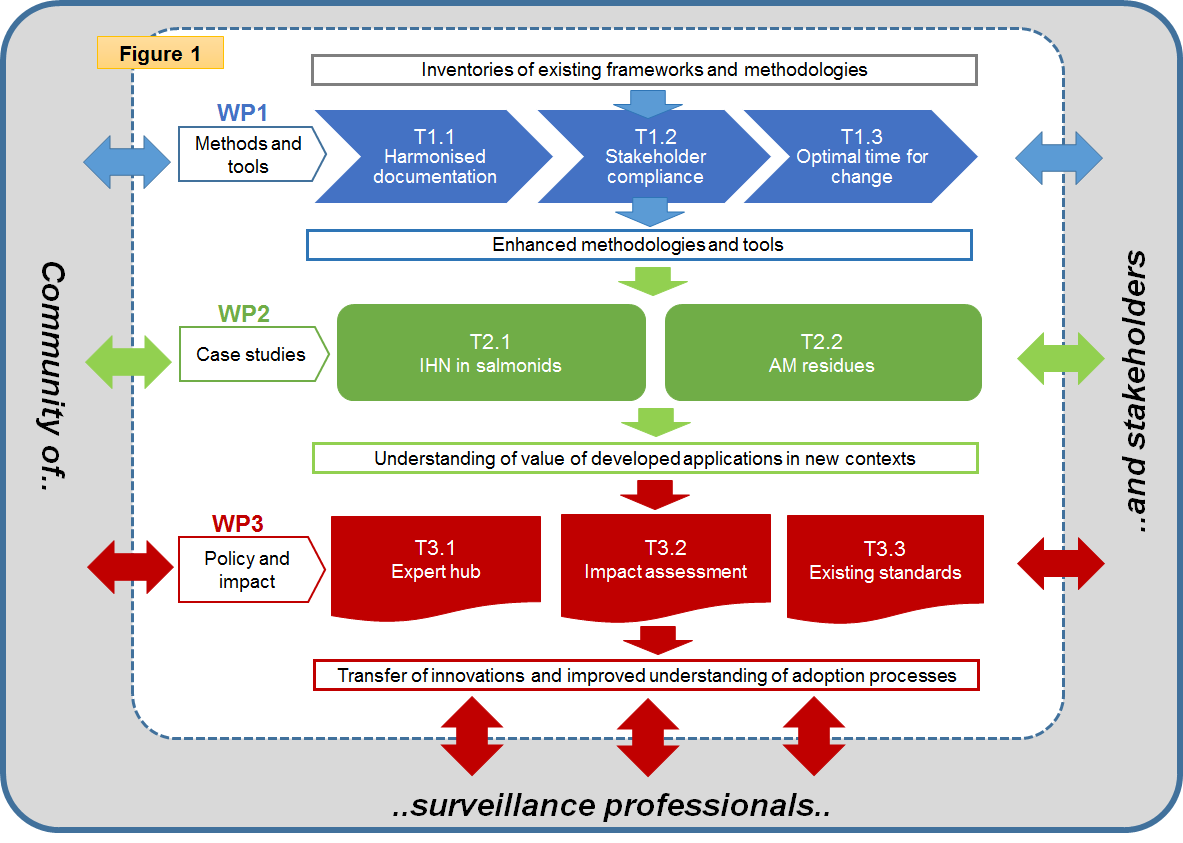Project architecture
The project is organized into three work packages, each consisting of 2-3 tasks, with inputs and outputs as shown in Figure 1.

WP1 will focus on technology and process development to standardize surveillance documentation and design features in order to increase uptake by targeted users and industries and to determine optimal times for changing surveillance objectives. The consideration of economics will be part of all relevant steps in the project.
WP2 will apply surveillance methods and tools previously developed by members of the consortium (as well as novel approaches generated in WP1) in populations and for hazards where risk-based surveillance is not yet widely adopted; in aquaculture and for antimicrobial residues. The aim is to gain experience in the practical application and to assess the utility of the methods and tools.
In WP3, an impact assessment will be conducted to study the uptake of novel surveillance approaches. Hurdles to implementation will be identified. The aim of WP3 is to build a knowledge hub that is freely accessible to surveillance users across Europe, thus providing a platform for the surveillance community to discuss and progress in the future.
Work packages and tasks
|
|
Tasks |
Description |
|---|---|---|
|
T1.1 Harmonized documentation of surveillance activities |
To meet the increased need for transparency when risk-based methods are used, harmonized documentation of active surveillance designs and outputs will be defined using consensus-based approaches. |
|
T1.2 Stakeholder uptake and compliance with active surveillance policies |
Factors that impact on surveillance compliance will be mapped, and novel methods, such as “nudging” will be explored for its usefulness in promoting stakeholders engagement with surveillance policies |
|
|
T1.3 Optimal time for a change in surveillance strategy |
Methods suitable for determining the technical and economic optimum for a change in surveillance strategy will be validated, including approaches to estimate the cost of error, together with guidance in evaluation practice |
|
|
T2.1 Infectious hematopoietic necrosis (IHN) in aquaculture of salmonids |
Risk-based surveillance approaches will be transferred to aquaculture building on existing experience with risk-based inspection. Link to task (T)1.1 |
|
T2.2 Antimicrobial residues |
Current surveillance practice will be compared to designs using risk-based approaches and related costs. Link to T1.1 and T1.3. |
|
|
T3.1 Expert hub |
A single point of contact will be provided for the surveillance community including policy makers across Europe. The vision is to create a long-term resource for rapid dissemination and adoption of novel surveillance methods, as well as the pacing of technology development with policy needs |
|
T3.2 Impact assessment |
Current progress in the adoption of recommended surveillance standards, novel approaches and best practices across countries will be assessed, with the aim to identify drivers and constraints to uptake and, by use of program theory, to identify pre-conditions required to achieve change in policy |
|
|
T3.3 Analysis of existing standards |
An inventory of existing standards for the case study hazards will be conducted, with an objective assessment of their strengths and weaknesses |
